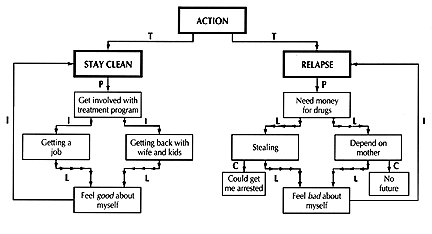A picture may be worth more than a thousand words when it comes to improving the effectiveness of drug abuse treatment, say researchers conducting a NIDA-funded study. When treatment practitioners used a simple visual representation technique called node-link mapping to depict and explore drug abuse re-covery issues in counseling sessions, opiate-addicted methadone treatment patients became more engaged in treatment and reduced their drug abuse and their AIDS-related risk behaviors, the researchers report.
"The results from using node-link mapping in drug abuse treatment have been far beyond what I expected," says Dr. Donald Dansereau of Texas Christian University (TCU), who originally developed the cognitive-enhancement technique in educational settings. Since 1989, Dr. Dansereau has been collaborating with Dr. Dwayne Simpson, who directs the Institute of Behavioral Research at TCU, to adapt, implement, and evaluate node-link mapping's effectiveness in improving drug abuse treatment services in community-based settings. The researchers have conducted a number of studies of the technique under the umbrella of the NIDA-funded Improving Drug Abuse Treatment for AIDS-Risk Reduction (DATAR) project. Those studies have shown that the technique can be an effective new therapeutic tool for drug abuse counselors, Dr. Dansereau says.
Node-link mapping is a method for visually representing a wide range of problems, issues, and potential solutions. When using the technique in drug abuse treatment, counselors and patients develop and draw a "map" or diagram as they write down the different aspects of a treatment issue that they are exploring. Arrows are used to link each statement or node of information to another to form the map. When complete, the map shows the relationship between patients' thoughts, feelings, actions, and consequences.
 Example of a node-link map drawn during a drug abuse counseling session. CLICK on the map to get more information on creating these drawings.
Example of a node-link map drawn during a drug abuse counseling session. CLICK on the map to get more information on creating these drawings.Mapping provides a visual reference that enables patients and counselors to explore the path to therapeutic solutions, Dr. Dansereau says. Creating the map also promotes increased patient interest and participation in group counseling, helps bridge communication gaps that often exist between counselors and patients from different backgrounds, and fosters better communication between counselors and patients who have difficulty paying attention or communicating verbally.
Studies conducted in the DATAR project show that the patients who participated in counseling sessions that used node-link mapping achieved significantly better treatment results than did patients who participated in standard counseling. Analyses conducted after 3 months of treatment also show that a diverse population of patients who received counseling using node-link mapping, including African Americans, Hispanic Americans, and patients who had difficulty paying attention, were more engaged in treatment and used drugs less often than patients who received standard counseling. Another study shows that opiate-addicted methadone treatment patients who also use cocaine used opiates and cocaine less frequently after undergoing 6 months of treatment enhanced with node-link mapping. Followup studies currently under way indicate that the link between node-link mapping and improved treatment outcomes is being maintained in the year following treatment, Dr. Simpson says.
Node-link mapping addresses an identified need to improve the thinking and planning skills of drug abuse treatment patients, Dr. Simpson says. "Cognitive reasoning has not generally been the strong suit of folks caught up in drug abuse," he explains. When mapping is used in counseling sessions, patients are better able to see inconsistencies in their thinking and the likely consequences of following specific courses of action, he says.
Node-link mapping also improves counselors' effectiveness, Dr. Dansereau says. Counselors are encouraged to adapt the technique to their individual counseling styles and use it only when they feel it enhances the treatment session. DATAR studies show that counselors find the technique particularly valuable in keeping group counseling sessions focused on the issue being discussed. Counselors rated group counseling with node-link mapping as being as effective as individual counseling sessions, Dr. Dansereau says.
In individual counseling, however, counselors say that the mapping technique sometimes interferes with important interpersonal interactions such as eye contact that foster patient-counselor rapport. To address this issue, the researchers are developing more structured "guide maps" that deal with common treatment issues. These maps contain blank nodes with headings that need to be completed. These simplified maps should reduce distractions during patient-counselor interactions, Dr. Dansereau says.
"I believe mapping is ready to be incorporated into community-based treatment," Dr. Dansereau says. "It does not require a major investment for treatment programs, no special equipment is required to use it, and it doesn't take much time or training for counselors to learn the technique." Counselors in the community-based methadone maintenance programs participating in the DATAR project learned how to use the technique in two 4-hour training workshops, he points out.
To order a node-link mapping training manual, see Study Finds Ways to Improve Drug Abuse Treatment Process
Sources
- Dansereau, D.F.; Joe, G.W.; Dees, S.M.; and Simpson, D.D. Ethnicity and the effects of mapping-enhanced drug abuse counseling. Addictive Behaviors, in press.
- Dansereau, D.F.; Joe, G.W.; and Simpson, D.D. Attentional difficulties and the effectiveness of a visual representation strategy for counseling drug-addicted clients. International Journal of the Addictions, 30(4):371-386, 1994.
- Dansereau, D.F.; Joe, G.W.; and Simpson, D.D. Node-link mapping: A visual representation strategy for enhancing drug abuse counseling. Journal of Counseling Psychology, 40(4):385-395, 1993.